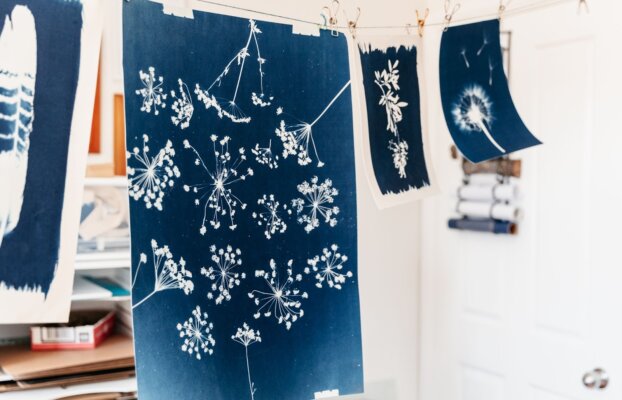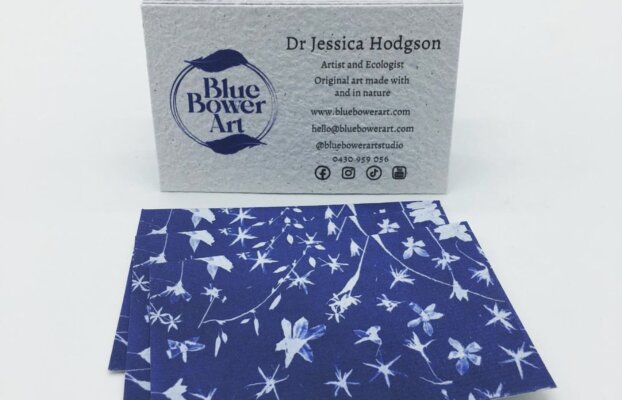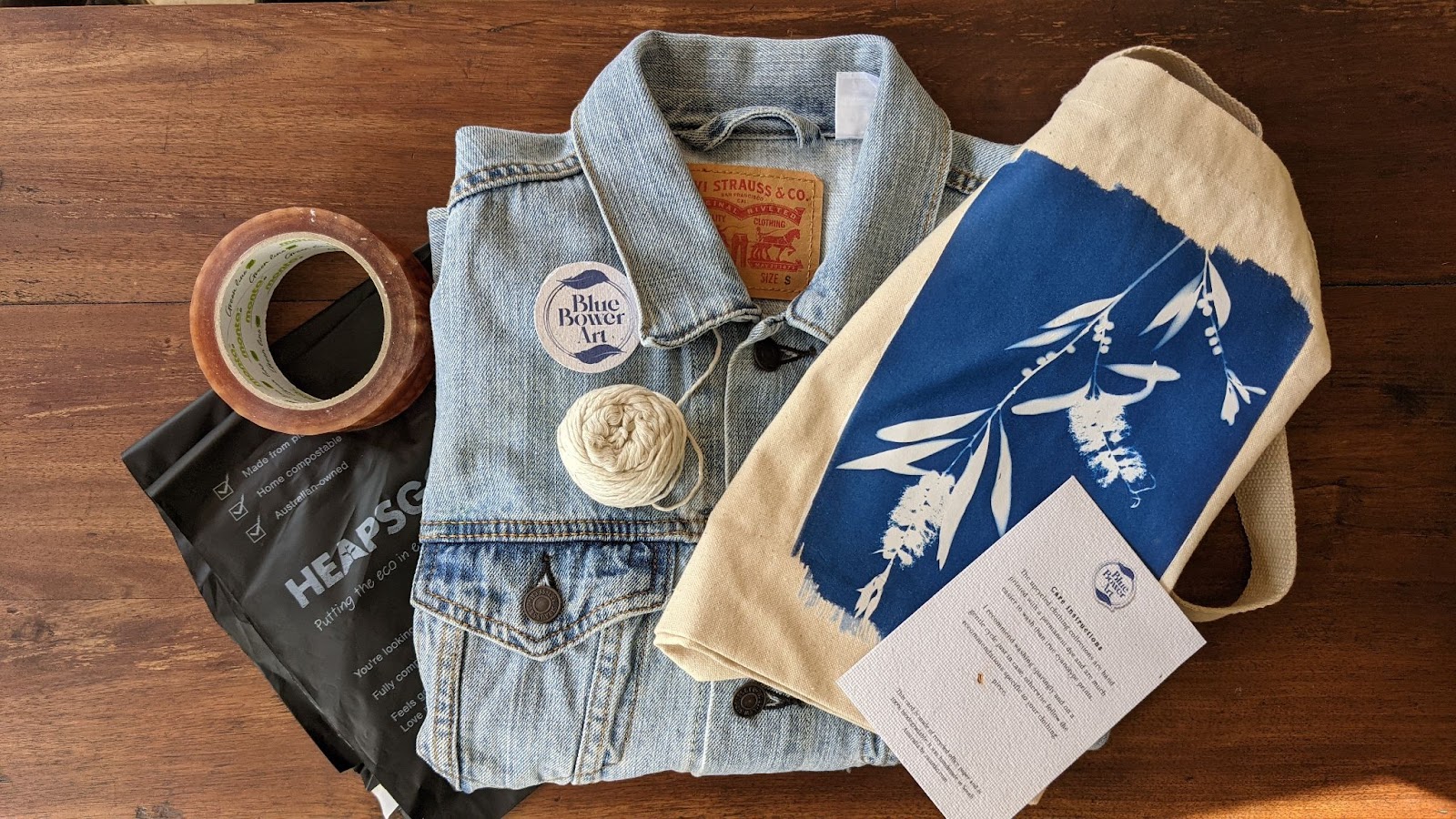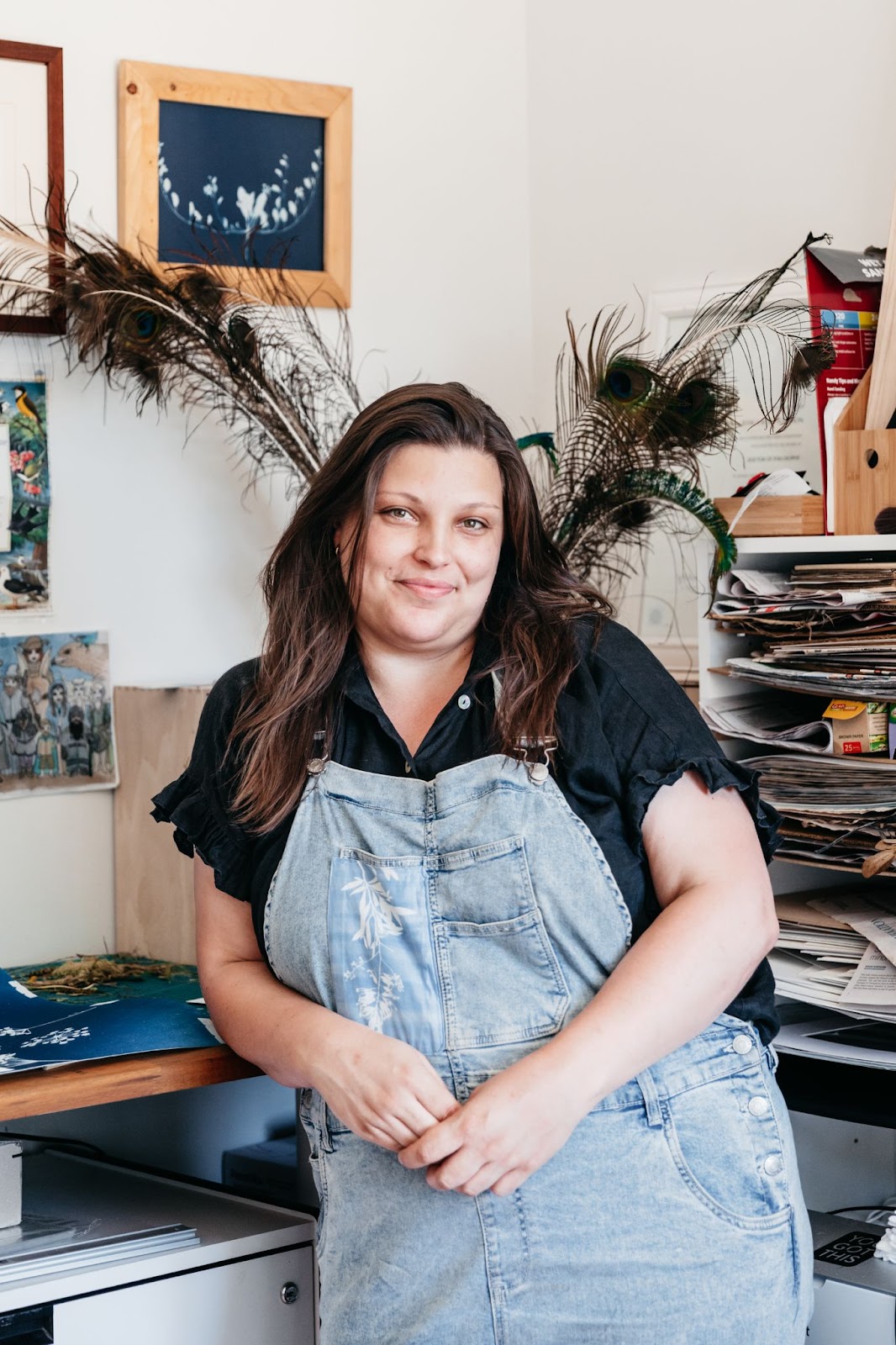Tips from a conservation ecologist and cyanotype artist small business owner.
My whole life has been surrounded by nature. My parents were avid gardeners, bird watchers and fishermen.
One of my favourite memories growing up was when we arrived at one of our favourite holiday spots on the NSW South Coast. It’s a tiny village on a lake that few people (back then) knew about, but Dad said it had the best fishing.
We arrived to discover a giant Lace Monitor (Goanna) in the tree by the front door, a microbat sleeping in the bedroom and every morning and evening the backyard would be descended upon by dozens of parrots, kookaburras and finches. At sunset, we would hear the wild dingoes howling and if we left a blue feather out in the garden, a male Satin bowerbird would sneak in and collect it for his bower of treasures.
A love of the natural world is a major facet of my identity, I even completed a PhD in Ecology. It is only natural then that a core value of my small business, Blue Bower Art, is eco-friendly and sustainable business products and practices.
I endeavour to produce my art and run my business in the most eco-friendly manner attainable. It is not perfect, but I improve my operations at every opportunity.
Hi, I’m Jess, an ecologist turned artist and small business owner specialising in wildlife and botanical cyanotype art.
What is cyanotype art, I hear you say? Don’t worry, you’re not alone, most people I speak to have never heard or seen cyanotype art before. So before I get stuck into my best tips for creating an eco-friendly business, let me introduce you to the captivating world of the cyanotype process.
What is cyanotype printing?

Cyanotype is an antique photographic printing process but there is no camera involved. Instead of a camera, an image is produced by exposing a chemically treated page with objects such as flowers and feathers on it to UV light (sunshine). The sunlight triggers a chemical reaction with the cyanotype solution turning everywhere light can reach, blue.
The cyanotype process was invented by an astronomist, Sir William Hershel in 1842, however its use was pioneered by a remarkable woman of the time, Anna Atkins. Anna was a botanist and was taught the process by Hershel himself. With it, she went on to self-publish a comprehensive photographic guide of both British algae and fern species by creating a cyanotype print of each one by hand. Each copy of the book had over 400 prints and it’s believed she produced about 20 of them. It was the first photographic book ever published and is still one of the rarest books in the world today.
You can learn more about the history of cyanotype, the process of creating cyanotype prints in general and Anna Atkins over on The Blue Blog at bluebowerart.com.
Are cyanotype prints eco-friendly?
Yes! One of the reasons why I have fallen in love and found myself in this process is because of its ability to be a sustainable art form when practiced with consideration. Some of the ways in which cyanotype prints are an eco-friendly art form are;
- Cyanotype printing can be achieved using zero electricity
- Prints can be achieved without damaging the specimens meaning that each one can be reused over and over again. This means that only the minimum amount is necessary.
Cyanotype printing began as a hobby for me but rapidly became a side hustle, and then when I had to leave my scientific career, cyanotype printing was my therapy through a very difficult time and is now my career. In the last 18 months or so of running Blue Bower Art I have learnt a thing or two about building an eco-friendly business. These are my top tips.
Eco-friendly practices in business
Packaging and shipping
Running a product-based business naturally results in a significant amount of parcels being delivered. Instead of throwing them away, I reuse as much as possible!
- Cardboard boxes are cut up and used in my numerous plant presses or they are used as weed mats in my garden and veggie beds.
Bubble wrap is recycled to package my own orders or taken with me to markets where it is also used to carefully package fragile products for customers.
- Many mailing satchels are home compostable (I get mine from Heapsgood.com.au)
- I have custom-designed packing tape made out of water-activated paper tape from Stickermule and compostable sticky tape from Heapsgood.
- Because I sell original artwork and prints, plastic sleeves for their protection are absolutely necessary, but they have been one of the hardest items to find an eco-friendly non-plastic alternative for. Unfortunately, not all of the sleeves I use are compostable or made from recycled resources but most are! I currently buy these from nomoreplasticpackaging.com.au. If you know of anywhere I can find compostable (or alike) sleeves for protecting prints in a diverse range of sizes – let me know!
Waste
Every handmade creator has attempted items that just didn’t work out. The ‘dud’ pile, if you will. Prints of mine that are not good enough to sell are recycled in a few ways.
- Fabric prints are cut up as patches for customers to buy cheaply and get creative with.
- Paper prints are either cut up and repurposed into greeting cards, or passed through a shredder to create eco-friendly protective packaging material
- The water I use in the development of prints is non-toxic and safe to be used as grey water on garden beds!
Suppliers
Being an eco-friendly business is not just about what you do with your materials once they are in your hands. It is just as important to do your research and support businesses that are environmentally friendly as well. My biggest tip is to do your research!
I implore you to not support massive, unethical corporations such as Amazon. It can be very difficult, I get it. Cyanotype solution, for example, is about a third to a quarter of the price on Amazon as it is from small independent art suppliers. It is tempting to buy from Amazon, I’ve been there, I’m guilty too. You do it because you worry that you won’t be able to stay competitive with others in the market, or maybe you’re looking to cut business expenses. But, if having eco-friendly and sustainable practices in your business are important values to you, it is a small price to pay. Make sure you are diligent in your research of potential suppliers and their values.
Specimen collection
Collecting native fauna and flora is actually illegal in most Australian states and territories. You can however, seek permits for permission but the type and their cost varies from state to state. All my specimens, both floral and faunal used in my cyanotype prints are collected under a permit or with permission on private property.
Stationery
I avoided having most business stationary such as swing tags, care instructions or thank you notes for a long long time because most people will toss them out moments after being received. I also hadn’t found a supplier that shared my values. I did have business cards from the beginning. My first batch were made from recycled cotton t-shirts but the issue with those was the company was based and printed in the UK and so I felt an immense guilt that they then travelled all the way to Australia. I then found Charlotte, a paper artisan that hand-makes the most beautiful paper from recycled office scraps in South Australia. Charlotte runs zwartko.com and I couldn’t recommend her more highly. She makes the paper, designs and prints anything your heart desires on them, and works with you to create a completely new product. But best of all, her customer service is just flawless.
- My business cards, swing tags, care instructions and greeting cards are now all printed on beautiful handmade paper embedded with native wildflower seeds. This means that they are home compostable or the customer can plant the card and be rewarded with wildflowers for years to come.

Website
Most people don’t realise that every website requires a significant amount of energy to run. Somewhere in the world, there is a physical server chugging fossil fuels to host your website. However, there are web hosts that operate on sustainable and renewable energy sources, or the company may purchase carbon credits. Whilst buying credits to offset energy use isn’t ideal, some companies will purchase double or triple the amount to offset their energy use leaving your website carbon neutral or even carbon negative. My website is currently hosted by Siteground, a well-ranked web host for their green initiatives.
I am by no means perfect but so far in my first 18 months as an eco-friendly business, these are some of the actions I have taken to implement sustainable and eco-conscious practices in business. I strive to improve at every opportunity. Tell me, what actions do you take to be kinder to our earth? Let us know in the comments below.
Written by Dr Jessica Hodgson
bluebowerart.com

